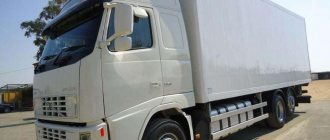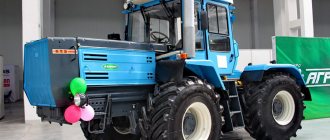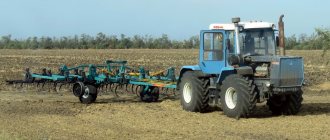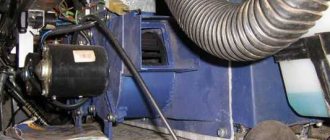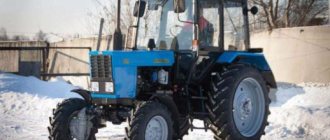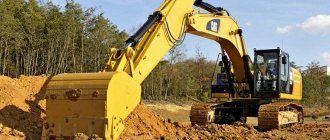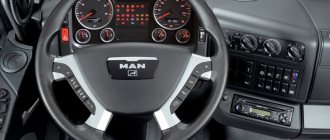Gearbox model ZF-16S151
The transmission of the ZF-16S151 model is a sixteen-speed manual, consisting of a four-speed main gearbox with a built-in two-stage divider located in front of the main box, and a two-stage planetary gearbox located behind the main box.
Rice. 3-66. Connection diagram for pneumatic control for the divider and multiplier: 1 - clutch reservoir; 2 — clutch pedal; 3 — gear shift lever; 4 — reverse sensor; 5 — valve for switching on the range multiplier; 6 — neutral sensor; 7 — sensor for switching on the low range of the range multiplier; 8 — range switching cylinder; 9 — first gear sensor; 10 — air distributor of the divider; 1 1 — sensor for switching on the low range of the divider; 12 — top gear engagement sensor; 13 - to the clutch slave cylinder; 14 — valve for switching on the divider; 15 — clutch master cylinder.
The gearbox consists of the following main components: a main four-stage gearbox, a front two-stage gear divider and a range-shifter. All forward gears in the main gearbox are activated by synchronizers, and the reverse gear is engaged by a gear clutch. The multiplier is planetary and is automatically switched using a pneumatic valve using a clutch synchronizer when the lever is moved.
Mechanical sixteen-speed, consisting of a main four-stage gearbox, a front two-stage gear divider and a multiplier
Max. input torque, N.m
L—lowest gear in the divider; S—highest gear in the divider; R - reverse
Roller needles with cages without rings
Inertial type, coupling with steel friction rings coated with molybdenum
With helical teeth, constant mesh
Non-contact, 6-prong inductor
All parts are splash lubricated; the bearings of the gearbox, divider and range gears also have additional feed from the oil pump
Behind the end of the main gearbox intermediate shaft
Gearbox control
Mechanical, with remote drive for the main gearbox (an option with a servo amplifier is possible), pneumatic preselector for the divider, pneumatic for the range-multiplier
Force on the gear shift lever, N (kgf), no more
Gearbox control
Gears are changed using a lever located to the right of the driver's seat. Switching the lever from one position to another is performed with the clutch disengaged (with the clutch pedal pressed). Press the clutch pedal sharply and fully. Gear changes are made at minimum idle speed (by tachometer or by ear) according to the gear shift pattern.
When slowing down, you should only change gears sequentially: 8-7-6-5-4-3-2-1.
You should only start driving from first gear to avoid premature clutch failure.
Gear shifting in the multiplier occurs automatically: high gear - when the control lever moves from the fourth to fifth position, low gear - when switching from fifth to fourth.
When the low range is turned on in the range multiplier, the control light (color - orange) lights up on the instrument panel.
When the lever is moved through the “O” position, the valve is activated, ensuring automatic switching of the range multiplier. When the range shifter is switched, the gear shift lever rod of the main box is blocked, and a force is felt on the lever, after which it is recommended to wait 1-1.5 s to ensure the gear shift in the range shifter.
To switch from an accelerating “S” gear in the divider to a decelerating “L” gear and vice versa (without shifting the lever), lower or raise the gear divider control switch located under the head of the gear shift lever, and then press and release the clutch pedal after a short (1s) delay — the transmission will start automatically.
Adjust the mechanical remote drive for controlling the gear shift mechanism of the ZF-16S151 model gearbox (Fig. 3-67) with the gear shift lever in the neutral position in the following order:
— completely unscrew nut 10;
— remove shank 9 from the conical hole of lever 5, releasing rod 3;
— fix rod 3 with technological rod 4 (d = 4 mm, 1 = 100 mm) in support 2;
— set lever 5 at an angle of 12°±3° to the vertical;
— rotating shank 9, align the axis of the conical pin with the hole in lever 5, tighten nut 10 to a torque of 40.50 N.m;
— holding shank 9 from turning with a wrench, tighten nut 15 to a torque of 98.147 N.m;
— remove the technological rod;
— by changing the length of rod 7, ensure the position of lever 1 and rod 3 in the vertical plane. The deviation of lever 1 and rod 3 from the vertical is no more than 2 mm;
— tighten nuts 14 to 40.50 Nm.
Adjust the position of bolt 12 on the clutch pedal if necessary:
— screw in bolt 12, having first unscrewed its locknut;
— press the clutch pedal all the way down;
— unscrew bolt 12 until its spherical part comes into contact with the plane of the head of the valve rod for switching on the divider 11;
- additionally unscrew bolt 12 by approximately 4 - 4.5 turns, ensuring that the head is recessed by 5-6 mm when the clutch pedal is pressed all the way;
— tighten the locknut of bolt 12.
Rice. 3-67. Drive for controlling the gear shift mechanism of the ZF-16S151 gearbox: 1 - gear shift lever; 2 — gear shift lever support; 3 - traction; 4 - rod; 5 — lever; 6 — thrust bracket; 7 — jet thrust; 8 — front panel; 9 — shank; 10 - nut; 11 — valve for switching on the divider; 12 — adjusting bolt; 13 — clutch pedal; 14, 15 - nut, I - to the center differential lock valve.
Gearbox zf 16s151 diagram design and repair
Disassembly of the ZF 16S gearbox is carried out after removing the box from the car. Also, before disassembling the gearbox, it is necessary to clean it. A condition for carrying out repair work is the use of a tool recommended by ZF.
After disassembly, be sure to clean all components of the ZF 16S gearbox . This applies primarily to corners, pockets and inclined surfaces of the body and covers.
Carefully remove caulk and flat seals. Check lubrication holes, grooves and lines for free passage. They must be free of deposits, foreign bodies or preservatives. The last requirement applies primarily to new parts.
Parts accidentally damaged during disassembly of the ZF 16S gearbox must be replaced with new ones (for example, shaft sealing rings, O-rings, U-shaped seals, caps, protective caps, etc.). Parts such as rolling bearings, shims, synchronizer parts must be checked by a specialist who will give an opinion regarding the possibility of their further use.
Flat seals are installed dry, i.e. free of oil or grease. Places where the use of flat seals is not provided are sealed using a heat- and oil-resistant sealant of plastic consistency (for example, type WEVO-L 100 A).
Disassembling parts of the range multiplier
1.1. Plastic pipelines
NOTE: Before dismantling, mark the pipelines according to their connections.
Remove the hollow bolts 1 and 2 from range cylinder 3 and range activation valve 4. Loosen the clamp 5 on the crankcase and completely remove the pipelines.
1.2. Output shaft flange
- Remove lock washer 1 from bolts 2.
- Stop the output shaft flange from turning.
- Remove the hex head bolts 2 and the clamping washer 3.
- Place the spacer on the planetary gear carrier and, using a puller with two or three jaws, remove flange 4.
- Remove O-ring 5.
- Unscrew the hexagonal head bolts and remove cover 1 with gasket 2.
- Unscrew the hexagonal head bolts and remove the cover 3 along with the gasket 4, cuff 5, compensating washer 6 and ball bearing 7.
- Using a plastic drift, remove the ball bearing from the cover. Remove the loose compensating washer. NOTE: With helical gears, the ball bearing is located on the output shaft. In this case, it should be removed using a puller. It should be borne in mind that in some designs of boxes for removing a ball bearing, a puller 1X56 122 314 is required, which has not ten, but eleven legs.
- Using a plastic mandrel, remove the cuff from the cover.
Rear splitter disassembly
1.4. Divider activation valve
- Remove the divider switch valve 1 of the ZF 16S gearbox
- Be careful not to lose the O-rings 2. NOTE: The valve cannot be disassembled - it is a single piece. NOTE: The gearbox type 8 S 151 does not have such a valve.
1.5. The cylinder that controls the activation of the range multiplier
- Remove the hex bolts. Remove cylinder 1 from the range housing and separate it from piston 2.
- Remove O-rings 3 and 4 from the cylinder.
- Remove stop 5 of the clamp. Screw the retainer 1X56 137 579 into the same threaded hole. Position the lock on rod 6 of the gear shift fork. Tighten the clamp (tightening torque: 50 N.m).
- Unscrew locknut 7 on piston 2.
- Remove the piston together with guide ring 8.
- Remove U-rings 9 or O-rings 11 (the latter are available only in new designs).
- Remove the guide ring and U-rings from the piston.
- Remove the cap collar 10 from the range housing.
1.6. Range housing
- Remove the mechanical tachograph or pulse sensor 15.
- Remove the connecting bolts 1 of the oscillating fork 2.
- Remove the retainer 1X56 137 579 again.
- Unscrew the hexagonal head bolts of the range housing 3. DANGER. The planetary group is located on the secondary shaft without fixation. Secure it from possible fall.
- Without turning it over, separate the range housing 3 from the housing 5 in the middle part of the box and remove it. In doing so, be guided by the cylindrical pins 4.
- Remove the swinging fork 2 together with the breadcrumbs 6.
- Remove spacer 7 together with gaskets 8.
- Remove switch 9 along with the sealing ring and pin 10. New designs may also have parts 13 and 14.
- Remove rod 11 of the gear shift fork from the middle part of the housing.
- Pick up the handset 12.
Disassembling the planetary mechanism
1.7. Planetary gear with synchronizer mechanism
NOTE: Before removing, secure the planetary mechanism against possible fall. Completely remove the planetary gear together with the synchronizer from the secondary shaft.
DANGER. The clamps are pressed by springs. Secure them from falling by wrapping a piece of cloth around them.
- Place the stop on the planetary carrier. Grab the sliding coupling 1 from below with a two- or three-jaw puller and remove it together with the body of the gear coupling 2. The clamps 4 and springs 5, held by the coupling, will be caught by a piece of cloth when they fall out of the coupling. NOTE: For spur-cut designs, the speedometer worm or speedometer drive mechanism disk 3 with built-in bushing is removed together with the gear coupling housing 2. NOTE. For parts marked with *, see specification.
- Remove the blocking ring 6 of the synchronizer.
- Remove the spring-loaded thrust ring 7.
- Place the stop on the planetary carrier. Grab synchronizer hub 8 from below with a two- or three-jaw puller and remove it.
- Remove the blocking ring 9 and the gear coupling housing 10 from the planetary gear carrier.
- When working with a puller, install a thrust bearing under the screw and the end of the carrier.
Disassembling the planetary gear carrier
1.7.2 Ring gear
- Insert, spring-loaded, the thrust ring 7, mentioned in section 1.7.1. onto the ring gear holder. Place the stop on the planetary carrier and grab the stop ring from below with a two- or three-jaw puller.
For spur gears:
- Ring gear 1, ring gear holder 2 and ball bearing 5 are removed together.
- Remove the cotter pin spring 4 from the annular groove on the ring gear.
- Using a plastic hammer, knock out holder 2 from the ring gear.
- Remove the spring-loaded retaining ring 3 from the ring gear holder. Then remove the ball bearing 5.
- Remove the spacer ring 6 from the planetary gear carrier.
For helical gears:
- Ring gear 1, ring gear holder 2, spacer ring 3 and thrust needle bearing 5 are removed together.
- Remove the cotter pin spring 4 from the annular groove on the ring gear.
1.7.3. Disassembling the planetary gear carrier.
Planetary carrier
- Push spacer pins 1 along their entire length into axis 2 of the planetary gear.
- Using a plastic mandrel, knock the axle out of the 3rd planetary gear carrier towards the output shaft.
- Remove satellite 4 together with adjusting washers 5 from the carrier. NOTE: Adjusting washers 5 are available only for spur gears. To facilitate subsequent assembly, the end surfaces of the satellite axis 2 and carrier 3 can be marked radially with a felt-tip pen before disassembly.
- Remove spacer rings 6 and cylindrical rollers 7 from the satellite.
- Remove the spacer pins (1) from the satellite axis
For all other planetary gears, repeat steps 1 - 5.
1.8.Assembling the planetary gear mechanism together with the synchronization mechanism
Planetary carrier
NOTE: Always replace satellites as a set.
- Lubricate the set of satellites on the end surface and on the guide surfaces of the cylindrical rollers with operating oil.
- Install axis 1 of the satellite so that the shoulder is directed downwards.
- Place adjusting washer 2 on the axle. In this case, the coated side (light side) should be directed towards the satellite. NOTE: Adjusting washers 2 are available only for spur gears.
- Install spacer ring 3 on the axle in any position.
- Place satellite 4 on pin 1 and center.
- Insert 14 pieces of cylindrical rollers into the satellite and install spacer ring 3 in the desired position.
- Lubricate the inside of the satellite with operating oil and insert the remaining 14 cylindrical rollers.
- Lubricate the surface of the cylindrical rollers with operating oil and put on the spacer washer.
- Install the shim. The coated side of the washer should face the satellite.
- Install planetary carrier 7 onto the shaft.
- Carefully remove the satellite from the axle along with the adjusting washers and insert it into the carrier.
- Align the satellite with hole 8 of the bearing. NOTE: The designation “0” located on the end side of the satellite axis must be directed towards the outer radius of the carrier (the lubrication hole must be directed towards the inner radius of the carrier).
- Radially center the pinion axis and insert it into the bearing hole.
- Insert the axle completely into the bearing hole by tapping it with a plastic hammer. Check the alignment of the spacer pin holes.
- Drive in half the new spacer pin 9. Drive the second (also new) spacer pin 10 into the first spacer pin, moving it approximately 180 degrees (due to the existing grooves). Press both spacer pins together into the carrier approximately 0.5 mm. (Follow the installation instructions).
- Check the axial clearance (0.4 to 1.3 mm) of the planetary gears.
Demultiplier - “double H” switching
The switching is divided into 5 passes located next to each other. There is a spring-loaded neutral position in the 3/4 or 5/6 passages.
Different springing allows good orientation in the gear shift pattern. Pneumatic switching of the range multiplier is carried out automatically when moving from aisle 3/4 to aisle 5/6 and vice versa.
Switching circuit ZF double H
Demultiplier - switching “overlapping H”
The switching is divided into 3 passes located next to each other. There is a spring-loaded neutral position in the 3/4 or 7/8 passage.
Pneumatic switching of the range when moving from aisle 3/4 to aisle 5/6 and vice versa is carried out using a preselector switch on the gear shift lever (Fig. 3a).
ZF switching pattern "overlapping H"
The range shifter control consists of a shift valve (35) and a double-acting pneumatic cylinder (34) located in the gearbox.
Rice. 34 - Pneumatic cylinder 35 - Switching valve
Front divider
The front divider is switched using a switch located on the gear shift lever (Fig. 3 and 3a). With this switch, the driver can select the slow and fast front splitter group, which is pre-selected by the driver using the switch and which is activated when the clutch pedal is pressed.
Switching is carried out with the clutch pedal fully depressed. Depending on the operating conditions of the vehicle, any gear can be divided. Please observe the vehicle manufacturer's specifications when doing this.
Design and principle of operation of the DAF gearbox
Modern transmissions used in DAF trucks:
- mechanical - 16 speeds with direct drive system;
- automated - 12 or 16 gears with the function of transmitting power to a hypoid rear axle equipped with a differential locking mechanism.
Some models, such as the five-speed hydromechanical manual transmission, can be made to order. Although many people prefer to manually control the transmission of their tractor, with the current density of traffic, automatic models are becoming more and more profitable. Switching the speeds of the DAF gearbox according to the scheme: pneumatic switching cylinders, controlled by solenoids, actuate the forks, with the help of which the scenes are activated.
DAF automatic transmissions can be supplemented with power take-offs that transmit torque to the drive of additional equipment, intarders that allow you to slow down the car without using brakes, a servo shifter, a synchronized range and divider to provide a low or high range of gears, a clutch housing, as well as devices that allow you to use an automatic transmission. as a mechanic.
The DAF AS Tronic transmission uses a combination of an automatic dry clutch and an electro-pneumatic gearbox with dog clutches. The design consists of a main unit, a group of actuators, a lever, an expansion module, a driving mode switch, and a display for displaying all functions. Depending on the number of gears, the unit can be three- or four-stage.
Servoshift servo mechanism
The Servoshift servo mechanism consists of a mechanical-pneumatic control unit and a double-acting pneumatic cylinder.
Shifting of the Ecosplit gearbox with the Servoshift servomechanism is carried out as described in the gearbox control section, but with pneumatic reinforcement.
Advantages: • significantly shorter shift distances • lower effort when shifting gears
Content
- Design and principle of operation of the DAF gearbox
- Main operating features
- Pros and cons of gearboxes on DAF 95 and 105
- Possible problems and their solutions
The efficiency of transporting various cargoes depends on many factors (dimensions of the truck, route, optimization of loading, experience of the performers), but one of the most important is the serviceability and reliability of all mechanical components, especially the power plant and gearbox.
DAF gearboxes manufactured by ZF Friedrichshafen AG (AS Tronic) or directly by DAF are distinguished by high build quality, compactness, excellent maintainability, low weight, and also, thanks to regular improvement of components, progressive efficiency. Such complex devices have different operating algorithms and certain features.
Control
Following the following driving instructions will help ensure a more economical and fuel-saving driving experience:
- Drive at a medium speed range.
- Use the highest possible gear.
- Consider the situation on the road, be far-sighted.
- Avoid unnecessary braking and acceleration.
Starting the engine and moving away
- Close the parking brake system (prevents the vehicle from accidentally rolling away).
- Place the gearbox in neutral.
- Turn on the engine.
- Set the gear (mainly 1st gear, in order to spare the clutch).
- Release the parking brake and gently engage the clutch. Please also observe the vehicle manufacturer's instructions.
DANGER When leaving the vehicle with the engine running, close the parking brake system. This prevents the vehicle from accidentally rolling away.
Pressing the clutch
CAUTION Shifting when the clutch is not completely disengaged will cause wear on the transmission timing.
Shifting the gearbox
The ZF Ecosplit gearbox is a synchronized gearbox. Synchronization is carried out by the transmission wheel synchronizer. Thanks to this, you can switch speeds faster and more reliably:
- without pressing the clutch twice when shifting to higher gears,
- without pressing the accelerator pedal or pressing the clutch twice when downshifting, even on slopes and in difficult situations.
ZF Technical Documentation Catalog
Ordering spare parts
S 5
S 5-42 (1307.050.363 PAVLOVO BUS) S 5-42 (1307.050.366 KAMAZ)
6S
6 S 800 TO (1346.001.007) 6 S 850 (1290.055.130)
6 S BO
6 S 700 BO (1351.001.017 KAVZ) 6 S 1200 (1350.003.037 KAMAZ)
8S
8S 1350 (1295 095 074 KAMAZ)
9 S TO
9 S 1310 TO (1324.001.048 KAMAZ) 9 S 1310 TO (1324.001.098 KAMAZ)
12 AS
12 AS 2331 TD (1353.041.012) 12 AS 2301 IT (1327.040.034)
12 AS IT
12 AS 2301 IT (1327.040.059 MAN)
16 S 151
16 S 151 (1315.051.141) 16 S 151 (1315.051.760) 16 S 151 (1315.041.711) 16 S 151 (1315.051.947 IVECO) 16 S 151 (1315.051.989 RENAULT)
16 S 151 IT
16 S 151 IT (1315.041.719)
16 S 181
16 S 181 (1316.055.009) 16 S 181 (1316.055.139) 16 S 181 (1316.055.200)
16 S 181 IT
16 S 181 IT (1316.046.102 1316.055.108 MAN)
16 S 221
16 S 221 (1316.051.196) 16 S 221 (1316.051.743) 16 S 221 (1316.051.935) 16 S 221 (1316.051.905 IVECO)
16 S 221 IT
16 S 221 IT (1316.041.103 1316.051.118 DAF TRUCKS)
16 S 251
16 S 251 (WSK 4130.065.212)
16S 1650
16 S 1650 (1297 095 111 MAZ)
16 S 1820 TO
16 S 1820 TO (1341.002.054 COMESA-MAZ) 16 S 1820 TO (1341.002.074 KAMAZ)
16 S 1920
16 S 1920 TD (1342.001.001) 16 S 1920 TD (1367.001.030 IVECO)
16 S 2220
16 S 2220 TD (1356.001.031 IVECO)
16 S 2220 TO
16 S 2220 TO (1342.002.001 MAN) 16 S 2220 TO (1367.002.030 IVECO)
16 S 2225 TO
16 S 2225 TO (1367.031.012 IVECO)
16 S 2230
16 S 2230 TD (1356.001.040)
16 S 2231
16 S 2331 TD (1356.052.026) 16 AS 2231 TD (1328.042.009)
16 S 2520
16 S 2520 TO (1343.002.056)
16 S 2601 IT
16 AS 2601 IT (1328.040.024 / 1328.001.049)
4 W.G.
4 WG 160 (4656.054.117) 4 WG 200 (4644.024.146)
6 WG
6 WG 190 (4657.026.105)
ZF catalog – innovations for any type of transport
The world-class company ZF is considered one of the leaders in the car market in the production of equipment. ZF catalog presents a wide range of spare parts for any type of transport. The most common use of these products is for passenger cars and commercial vehicles. The company guarantees the high quality and reliability of its products.
Application of ZF spare parts on different types of transport
The range of spare parts, in addition to systems and components of gearboxes, such as zf 16 - a manual gearbox designed for heavy-duty vehicles - up to 40 tons or zf 9s1310 - a 9-speed gearbox for medium-duty trucks, includes suspension components, chassis and transmissions for various types of vehicles:
- passenger car;
- cargo and commercial - zf 16s151;
- buses;
- motorcycles;
- various construction equipment.
The use of Polar Division innovations in passenger vehicles increases efficiency, safety and operating comfort. ZF gearbox control systems, used on trucks and commercial vehicles from the 9-speed zf 9s1310 gearbox to the zf 16s181 designed for heavy-duty vehicles, significantly increase their operating efficiency. The components used in passenger transport make it more attractive and its operation more economical. The products guarantee mobility when operating any type of transport in any conditions.
The entire range of products, from zf 2 to 16-speed gearboxes
Despite the fact that the specialization of the German concern's products is quite wide, its most common use is in passenger cars, trucks and commercial vehicles. The product catalog presented on our website today includes the following units and components:
- manual gearboxes for various types of transport, including zf 2 and gearboxes for heavier-duty vehicles zf 16s181;
- automatic transmissions for cars and trucks;
- clutch;
- power steering;
- drive axles and suspension systems;
- various components for industrial vehicles, including clutches, brakes and gearboxes.
All spare parts for the repair of manual and automatic transmissions, power steering, pumps, as well as oils are always available in our warehouse.
Why choose ZF products
This German concern has been producing spare parts for a hundred years. The company's products are widely distributed and used by the world's leading vehicle manufacturers. The centuries-old traditions of German quality have long been appreciated by millions of users.
Gearboxes and other ZF spare parts are used on Russian-made vehicles of various payloads and passenger vehicles. Today, BMW, Iveco, MAN, Renault, Kamaz, and Ural cars are equipped with components. What are the advantages of using gearboxes and other components from a German manufacturer in cars?
- Fuel economy. Thanks to shorter shift strokes and an optimal number of gearbox steps, including the zf 16s151, fuel consumption is reduced.
- Making the driver's work easier. Multi-speed transmissions, such as the zf 16, allow you to change gears less frequently.
- Reliable operation in any conditions.
- More comfortable and safe operation. Innovative suspension designs provide a smooth ride and improved handling.
The products of the German company are for those who value quality, comfort and reliability.
Towing a disabled vehicle
Towing of a disabled vehicle is possible
only if the following conditions are met:
- with built-in spare steering pump,
- with the fast range group switched on, the shift lever is in the neutral position,
- at a distance of no more than 100 km,
- The maximum permissible towing speed should be determined depending on the axle gear and tire size according to the diagram shown (Fig. 10).
Follow the vehicle manufacturer's instructions.
If one of the above conditions is not met, then the driveshaft flange on the rear axle must be disconnected or the removable axles must be removed.
If there is a suspicion of damage to the gearbox, then the propeller shaft flange on the rear axle should also be disconnected or the removable axles should be removed.
Fig.6. Reading example: iocb = 6, RdllH = 0.5 m Towing speed from the diagram: Umax = 25 km/h
Follow local regulations regarding maximum towing speed.
Driving a car when there is a malfunction
Malfunctions when changing the range group (for example, when moving from aisle 3/4 to 5/6 and vice versa) can have the following reasons:
- damage to pipes in the pneumatic system,
- The switch valve (35) or the switch cylinder (34) for the range multiplier is faulty (condensation or contamination).
- The further path is possible only if the slow range group is turned on (gears 1 - 4).
- If the fast range group remains on, the vehicle should be towed.
Rice. 7 34 — Switching cylinder for range multiplier 35 — Switching valve for range multiplier
Putting the vehicle into operation at low temperatures
The gearbox is filled with oil according to the ZF lubricant specification TE-ML 02. At temperatures below -15 °C, check whether the oil is suitable according to the lubricant specification TE-ML 02. If necessary, change the oil in the gearbox. An alternative option is to preheat the engine before starting; this can be done, for example, with warm air, the temperature of which at the gearbox should not exceed 130 °C.
DANGER When leaving the vehicle with the engine running, close the parking brake system. This prevents the vehicle from accidentally rolling away.
NOTE • Always follow the vehicle manufacturer's instructions.

